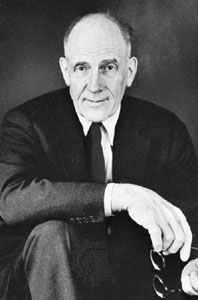
Wallace Kirkman Harrison was an American architect. Harrison started his professional career with the firm of Corbett, Harrison & MacMurray, participating in the construction of Rockefeller Center. He is best known for executing large public projects in New York City and upstate, many of them a result of his long and fruitful personal relationship with Nelson Rockefeller, for whom he served as an adviser.

Louis Isadore Kahn was an Estonian-born American architect based in Philadelphia. After working in various capacities for several firms in Philadelphia, he founded his own atelier in 1935. While continuing his private practice, he served as a design critic and professor of architecture at Yale School of Architecture from 1947 to 1957. From 1957 until his death, he was a professor of architecture at the School of Design at the University of Pennsylvania.

Albert Kahn was an American industrial architect. He was accredited the architect of Detroit and designed industrial plant complexes such as the Ford River Rouge automobile complex. He designed the construction of Detroit skyscrapers and office buildings as well as mansions in the city suburbs. He led an organization of hundreds of architect associates and in 1937, designed 19% of all architect-designed industrial factories in the United States. Under a unique contract in 1929, Kahn established a design and training office in Moscow, sending twenty-five staff there to train Soviet architects and engineers, and to design hundreds of industrial buildings under their first five-year plan. They trained more than 4,000 architects and engineers using Kahn's concepts. In 1943, the Franklin Institute posthumously awarded Kahn the Frank P. Brown Medal.
This is a timeline of architecture, indexing the individual year in architecture pages. Notable events in architecture and related disciplines including structural engineering, landscape architecture, and city planning. One significant architectural achievement is listed for each year.
The year 1959 in architecture involved some significant architectural events and new buildings.
The year 1977 in architecture involved some significant architectural events and new buildings.
The year 1994 in architecture involved some significant architectural events and new buildings.
The year 1972 in architecture involved some significant architectural events and new buildings.
The year 1885 in architecture involved some significant architectural events and new buildings.
The year 1936 in architecture involved some significant events.
The year 2005 in architecture involved some significant architectural events and new buildings.
Romaldo "Aldo" Giurgola AO was an Italian academic, architect, professor, and author. Giurgola was born in Rome, Italy in 1920. After service in the Italian armed forces during World War II, he was educated at the Sapienza University of Rome. He studied architecture at the University of Rome, completing the equivalent of a B.Arch. with honors in 1949. That same year, he moved to the United States and received a master's degree in architecture from Columbia University. In 1954, Giurgola accepted a position as an assistant professor of architecture at the University of Pennsylvania. Shortly thereafter, Giurgola formed Mitchell/Giurgola Architects in Philadelphia with Ehrman B. Mitchell in 1958. In 1966, Giurgola became chair of the Columbia University School of Architecture and Planning in New York City, where he opened a second office of the firm. In 1980 under Giurgola's direction, the firm won an international competition to design a new Australian parliament building. Giurgola moved to Canberra, Australia to oversee the project. In 1989, after its completion and official opening in 1988, the Parliament House was recognized with the top award for public architecture in Australia.
The year 1904 in architecture involved some significant architectural events and new buildings.
The year 2006 in architecture involved some significant architectural events and new buildings.

Contemporary architecture is the architecture of the 21st century. No single style is dominant. Contemporary architects work in several different styles, from postmodernism, high-tech architecture and new interpretations of traditional architecture to highly conceptual forms and designs, resembling sculpture on an enormous scale. Some of these styles and approaches make use of very advanced technology and modern building materials, such as tube structures which allow construction of buildings that are taller, lighter and stronger than those in the 20th century, while others prioritize the use of natural and ecological materials like stone, wood and lime. One technology that is common to all forms of contemporary architecture is the use of new techniques of computer-aided design, which allow buildings to be designed and modeled on computers in three dimensions, and constructed with more precision and speed.
Ernst Anton Plischke was an Austrian-New Zealand modernist architect, town planner and furniture designer whose work is well known throughout Europe and New Zealand.
The year 2012 in architecture involved some significant architectural events and new buildings.
Francis Gordon Wilson was an Australian born, New Zealand architect. Wilson oversaw the design of New Zealand’s state housing programme from the 1930s onwards. He was the New Zealand Government Architect at the time of his death.

Harrold Herbert Jory, known as Herbert Jory, was a South Australian architect. He was a partner in the leading firm of Woods, Bagot & Jory from 1913, which became Woods, Bagot, Jory & Laybourne Smith from 1915 to 1930, before establishing his own practice, H. H. Jory. Between 1930 and 1940 he partnered with T.A. McAdam, in Jory and McAdam.







